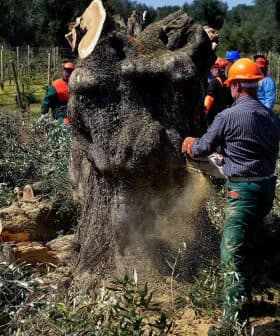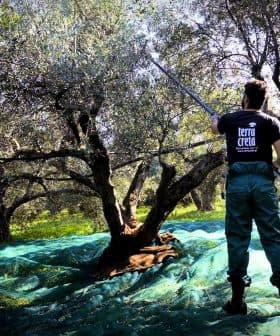Ultrasound Can Improve Extra Virgin Olive Oil Extraction
Researchers have developed an affordable extraction system using ultrasound that can improve quality and increase yield.
 Maria Lisa Clodoveo
Maria Lisa ClodoveoA team of researchers from the University of Bari focused on improving the malaxation stage in olive oil production by introducing ultrasound technology, resulting in increased oil extraction yields and higher concentrations of polyphenols and antioxidants. The use of ultrasound in a continuous-cycle mill increased yield from 14.5 percent to 16.5 percent, while also enhancing the content of healthy molecules in the olive oil without affecting its chemical or organoleptic properties.
A research team from the University of Bari has been focusing on optimizing the malaxation stage in olive oil production. Malaxation is the step when the olive paste is stirred before it is separated in a centrifuge.
“The main objectives of research in the field of extraction are essentially three concerning the malaxing phase: to reduce the length of this step, to improve the heat exchange and to increase the oil extraction yields without negative effects on the phenol content,” Maria Lisa Amirante Clodoveo from the University of Bari Aldo Moro explained.
The reduction of procedure and resource consumption, coupled with the maintenance of quality, contributes to guaranteeing better profits.
“The traditional systems, such as warming up the olive paste, adding water and prolonging the duration of malaxation have been stressed out to the point that it appeared necessary to introduce something new to benefit more in terms of yield and efficiency,” Clodoveo said.
In this sense, the first objective of the researchers coordinated by Clodoveo was to find a solution to improve this operation. The malaxer is a batch machine which works between two continuous devices (the crusher and decanter), and it is an inadequate heat exchanger, due to the unfavorable ratio between its small surface compared to the big volume of olive paste withi it.
Worldwide, emerging technologies from microwaves to pulsed electric fields have been tested and used, but the group of Italian researchers focused on ultrasound. In addition to their effect on modulating the chemical, physical and biochemical reactions within the crushed olive paste, ultrasound offers low-cost devices, easy scalability and high sustainability of the process from an energetical point of view.
Hence, researchers wanted to present a technical solution that would be affordable for a wide range of producers to increase yields and quality without additional energy costs.

Maria Lisa Clodoveo
“We believed that ultrasound could be very promising since it exerts a bland thermal action combined with a considerable mechanical action,” Clodoveo explained. The mechanical action is due to the cavitation which, in simple terms, consists in the formation of microscopic vapor bubbles caused by the oscillations in pressure values.
The bubbles reach a critical diameter until they violently implode, generating fluid jets that break up those cells which have passed through the crusher intact. However, not all ultrasound frequencies are able to generate the effective cavitation inside the olive paste. During simulation tests, the researchers verified that only a low-frequency ultrasonic range (20 – 50 kHz) is useful to reach the goal.
Essentially, many cells pass through the crusher without breaking until they end up in the malaxer. “Thanks to ultrasound, cavitation instantaneously causes the rupture of these cells, releasing oily droplets and minor compounds,” the researcher explained. “This has a twofold effect consisting in a higher release of olive oil, and a higher concentration of polyphenols and antioxidants like carotenoids and tocopherols.”
By applying ultrasound in a continuous-cycle mill, the researchers observed an evident increase in yield, from approximately 14.5 percent with a conventional process to 16.5 percent with ultrasound.
Additionally, they assessed an increase of more than 20 percent of the polyphenols in the samples treated with an ultrasound system. “The content of molecules with healthy action, evaluated by Filomena Corbo, resulted higher than in traditional olive oil,” Clodoveo pointed out.
Also, the profile of chemical and organoleptic properties used for the classification of the product has not been affected, and there were no significant differences compared to the traditional system.
Moreover, the headspace analysis of the samples conducted with gas chromatography by Antonello Paduano revealed that the volatile compounds did not suffer any damage. This underlined that the delicate enzyme lipoxygenase pathway was not compromised by the thermal action of ultrasound.
“In order to meet the changing needs of the market, millers need plants with high efficiency, capable of limiting investment and management costs, reducing the processing time and maximizing the working capacity,” Clodoveo explained. “The reduction of procedure and resource consumption, coupled with the maintenance of quality, contributes to guaranteeing better profits,” she remarked.
The final step of the research required the collaboration with the Polytechnic University of Bari. “Thanks to the mechanical engineering skills of Riccardo Amirante we reached the industrial scale,” Clodoveo added, specifying that with the funding PerformTech from the Apulia Region, the machine reached a high level of technological maturity and it is now ready for release to the market.









